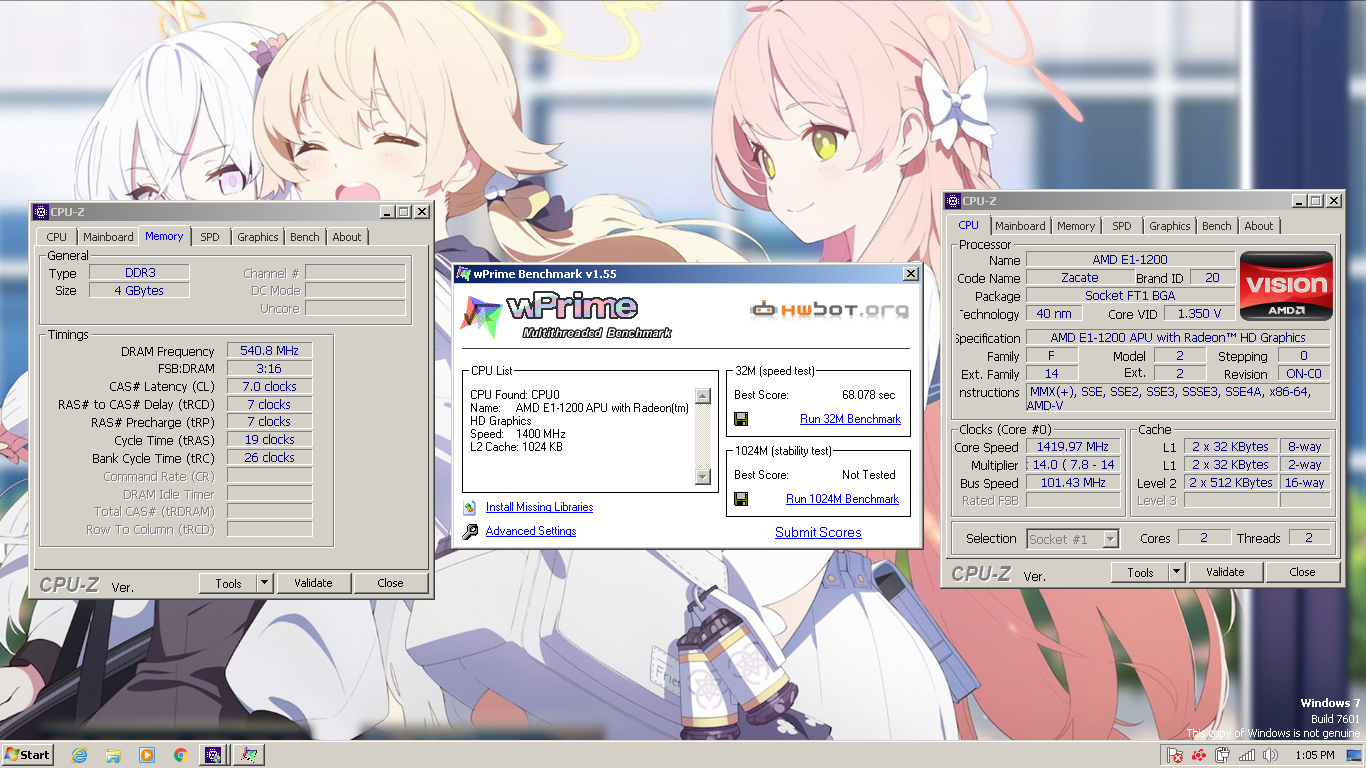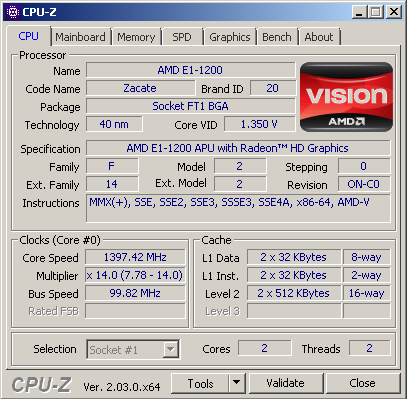wPrime - 32M score 1min 8sec 78ms with a E1-1200
Thursday, 01 January 1970 07:00 | Update at null
Media Gallery
Screenshot

Device, Setup, etc



URL
https://hwbot.org/submission/4948492https://www.facebook.com/hakimnu.id/posts/3232676343631673
Information Detail
Hardware: AMD E1-1200
Specs:CPUID : AMD E1-1200 APU with Radeon(TM) HD Graphics
Architecture : x86
Codename : Zacate
L3 Cache : -
Clock : 1.4GHz
Core/Thread : 2/2
TDP : 18W
Technology : 40nm
Socket : FT1 BGA 413-Ball
IGPU : AMD Radeon HD 7310
See more specification...
Software: wPrime - 32M
Score: 1min 8sec 78ms
About: wPrime - 32MwPrime - 32M is a computational math-based benchmark designed to measure processor performance by calculating prime numbers using a multi-threaded algorithm. In the 32M test, the benchmark calculates all prime numbers up to 32 million, with the main focus on execution speed and CPU processing efficiency. Unlike many other benchmarks that may only rely on a few cores, wPrime fully utilizes all available cores and threads on a processor, giving a very accurate picture of a CPU's multi-core scalability.
wPrime test results are usually reported in time (seconds), where the lower the time taken to complete the calculation, the higher the performance of the processor being tested. Due to its heavy and complex workload, both on the CPU and memory (RAM) side, wPrime - 32M is often used by overclockers and engineers to test system stability when overclocked and as a benchmark in comparing CPU performance in intensive parallel computing scenarios.
Overall, wPrime - 32M is a very popular and effective benchmark tool for assessing the parallel processing power of modern processors, especially for those looking to test the limits of heavy-duty hardware, both in the professional world and hobby testing.
Released in 2012 as part of the Brazos 2.0 family, the AMD E1-1200 is a power-efficient processor aimed at entry-level laptops. It has a 2 core and 2 thread configuration with a fixed clock speed of 1.4 GHz, with no support for Turbo Core technology. Built with a 40nm fabrication process, the E1-1200 has a TDP value of 18 watts-efficient enough for portable devices that emphasize low power consumption and longer battery life. Despite its limited performance, the E1-1200 was a popular choice in its day thanks to its affordable price and ability to handle light computing needs.
One of the main advantages of the AMD E1-1200 is the integrated Radeon HD 7310 GPU, which offers better graphics performance than Intel's entry-level graphics solutions at the time. This GPU has the ability to play HD resolution videos smoothly, as well as run light games such as Counter Strike 1.6, Plants vs Zombies, or other casual games with minimum graphics settings. That said, this combination of CPU and GPU is not intended for heavy-duty work such as video editing, 3D rendering, or modern gaming. Overall performance is more optimal when used for tasks such as browsing, streaming videos, accessing social media, typing documents, as well as basic office applications.
However, it should be noted that the AMD E1-1200 is less suitable for heavy multitasking, especially in modern operating systems like Windows 10. With a low clock speed and no Boost feature, users may experience lag or limitations when opening multiple applications at once. In tests using the HP 1000 1b05au laptop, this processor was paired with 4GB DDR3 single channel RAM (2 DIMM slots) and tested on Windows 7, Windows 8, and Windows 10 operating systems. The results show that the most optimal performance is achieved on Windows 7 or Windows 8, while in Windows 10 the system tends to be slow although it can still be used for basic needs. As such, the AMD E1-1200 can still be relied upon as a power-efficient and inexpensive solution for users with very light computing needs.
Hardware Detail:
Device: HP 1000 1b05au
RAM: 4GB DDR3 Single Channel 2 DIMM
OS: Windows 7, Windows 8, Windows 10
* Not Avaiable
